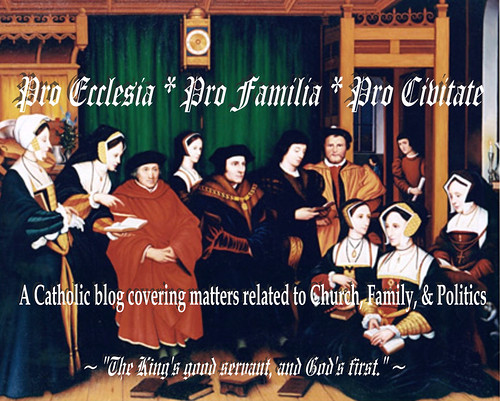Blessed Margaret Pole's Day, May 28
From the Medieval Saints Yahoo Site:
Blessed Margaret Pole
Also known as Margaret Plantaganet
Martyered: imprisoned in the Tower for two years and then beheaded "by a clumsy novice" 1541 at East Smithfield Green, EnglandBeatified 1886 by Pope Leo XIII
Commemorated May 28
The Story of Blessed Margaret Pole
There has always been a Catholic Mission at Havant. However, it is only through the dark days of penal times that the story of Havant's Catholic Community starts to come to life. Our story begins with the stubborn refusal of the people in this small corner of Hampshire to give up the old faith with the onset of the Reformation. The Reformation was in its infancy; before the minority of extreme Protestants had seized upon Henry VIII's split with Rome to sweep the church in England into a path that was to take it further away from the old beliefs and practices than Henry had ever wished or intended.
Our story begins at Warblington - a castle within sight of the sea, less than a mile from the centre of Havant.
In 1514 the Manor of Warblington passed into the hands of Margaret Pole who had been granted the title of Countess of Salisbury and permitted to succeed to her brother, Edward Earl of Warwick's estates in Hampshire, Wiltshire and Essex.
Margaret Pole was the last of the surviving members of the Royal House of Plantagenet and, as such, dangerously close to the throne ofEngland. Her father, the Duke of Clarence, had been murdered by his brother Edward IV and her brother had been put to death by Henry VII, probably because King Ferdinand of Spain had refused his daughter, Catherine of Aragon, to marry the Prince of Wales while this Plantagenet Prince lived to challenge the Tudor claim to the throne.
Catherine of Aragon afterwards believed that her own unhappiness in failing to bear a living son had come as a judgement because her marriage had been made in blood. She behaved with great compassion towards the murdered man's sister, an affection which Margaret Pole repaid with love and staunch support.
Margaret was made godmother and 'lady governess' to Princess Mary, a position which she kept after Catherine's divorce in 1533. Then, in 1534 came the formal separation from Rome. Henry was proclaimed supreme head of the Church in England and the people of England were forced to take sides in the King's quarrel. 'Either acknowledge King Henry as head of the church, or refuse and pay the penalty'. Men like Sir Thomas More and Bishop Fisher publicly refused to admit the King's right to such a title and died for their stubbornness. Margaret, Countess of Salisbury, was firm in her opposition to this new regime. Her lack of loyalty soon made her an enemy of the King and his new Queen. The Royal Commissioners took the Princess Mary from the Countess's care, and Margaret retired to Warblington.
Margaret possibly thought that, in this quiet part of Hampshire, she would be far from the Royal displeasure and be allowed to practice her Catholic faith in peace. However, such thoughts were soon cut short due to the activities of her youngest son, Reginald Pole. Reginald wrote some material denouncing the King's break with Rome. He called him 'wanton, a lecher, an adulterer and a heretic.... '. This provoked Henry to an intense hatred which embraced the whole Pole family. King Henry tried to have Reginald assassinated but he was in Italy and evaded the King's reach. Matters were made worse when Reginald was made a Cardinal. Reginald's brother, Lord Montagu, was executed for seeking absolution from Rome and his son Henry, still a child, was imprisoned in the Tower, as was Edward Courtney, son of Lord Exeter. (The purge had begun).
Margaret was arrested at Warblington on 12th November, 1538. She was taken to Cowdray Park and cross-examined by Fitzwilliam, Earl of Southampton and Goodrich, Bishop of Ely. No treason was proved against her.
The Castle at Warblington was searched, and some Bulls granted by the Bishop of Rome were found. Also, some vestments, depicting the Five Wounds Of Christ, were found. Henry declared that this connected Margaret Pole with the 'Pilgrimage of Grace'. It was also stated that she refused to allow her tenants to have the New Testament in English and corresponded with her son the Cardinal. Parliament passed an Act of Attainder on June 28th, 1539 and Margaret was removed to the Tower, where she was imprisoned until her death two years later.
Margaret Pole was one of the English Martyrs declared Blessed by Pope Leo XIII. In some contemporary notes on the Consecration of St. Joseph's Church, Havant, in 1907, it is stated that; "She is specially honoured in the Diocese of Portsmouth and is one of the Saints for whom Havant Catholics should have a special veneration."
---------------------------
More on Blessed Margaret Pole at:
http://www.stthomasirondequoit.com/SaintsAlive/id718.htm
http://www.saintpatrickdc.org/ss/0528.htm#marg
http://www.hullp.demon.co.uk/SacredHeart/saint/BlessedMargaretPole.htm
http://www.ewtn.com/library/MARY/MARGPOLE.htm
http://www.newadvent.org/cathen/09656b.htm
Labels: Anti-Catholicism, England, History, Religious Persecution, Saints and Martyrs, Traditional Feast Days



0 Comments:
Post a Comment
<< Home